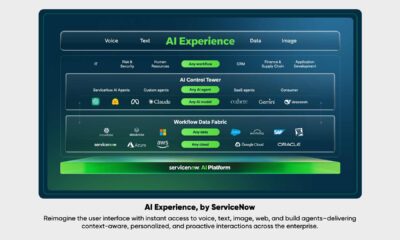Features
Use Cases, Applications, and Examples of AI in Logistics
Written by Cem Dilmegani
“The article was originally published on AIMultiple”
Artificial intelligence is transforming all industries and logistics is one of them. Logistics is the management of the flow of products between different locations. A global network of suppliers and customers complicates logistics operations and logistics companies contain both easy to automate tasks and complex processes that can benefit from AI/machine learning algorithms.
What does AI mean for logistics companies?
The technology offers a wide range of capabilities to logistics companies from autonomous machines to predictive analytics. According to Mckinsey research “AI adoption advances, but foundational barriers remain,” the logistics industry has adopted AI mostly for 4 business functions which are service operations, product and service development, marketing and sales, and supply chain management. These four business units cover 87% of AI adoption in logistics. Mckinsey estimates that logistics companies will generate $1.3-$2 trillion per year in economic value by adopting AI into their processes.
What are the applications of AI in logistics?
Planning
Logistics requires significant planning that requires coordinating suppliers, customers, and different units within the company. Machine learning solutions can facilitate planning activities as they are good at dealing with scenario analysis and numerical analytics, both of which are crucial for planning.
Demand Forecasting
AI capabilities enable organizations to use real-time data in their forecasting efforts. Therefore, AI-powered demand forecasting methods reduce error rates significantly compared to traditional forecasting methods such as ARIMA, AutoRegressive Integrated Moving Average, and exponential smoothing methods.
With improved accuracy in demand prediction,
- manufacturers can better optimize the number of dispatched vehicles to local warehouses and reduce operational costs since they improve their manpower planning
- local warehouses/ retailers can reduce the holding costs (opportunity cost of holding the item instead of investing the money elsewhere)
- customers are less likely to experience stockouts that reduce customer satisfaction
Supply Planning
Artificial intelligence help businesses analyze demand in real-time so that organizations update their supply planning parameters dynamically to optimize supply chain flow. With dynamic supply planning, businesses use fewer resources since dynamic planning minimizes waste.
Automated Warehousing
According to the 2020 MHI Annual Industry Report, only 12% of businesses are using AI technology in their warehouses, but it is expected to reach 60+% in 6 years.
Warehouse robots are another AI technology that is invested heavily to enhance businesses’ supply chain management. The warehouse robotics market was valued at USD 2.28 billion in 2016 and is expected to grow at a CAGR of 11.8% between 2017 and 2022.
For example, the retail giant Amazon has acquired Kiva Systems in 2012 and changed its name to Amazon Robotics in 2015. Today, Amazon has 200,000 robots working in their warehouses. In 26 of Amazon’s 175 fulfillment centers, robots helping humans for picking, sorting, transporting, and stowing packages.
Damage Detection/Visual Inspection
Damaged products can lead to unsatisfied customers and churn. Computer vision technology enables businesses to identify damages. Businesses can determine the damage depth, the type of damage, and take action to reduce further damage.
Predictive Maintenance
Predictive maintenance is predicting potential machine failures in the factory by analyzing real-time data collected from IoT sensors in machines. Machine learning-powered analytics tools enhance predictive analytics and identify patterns in sensor data so that technicians can take action before the failure occurs.
Autonomous Things
Autonomous things are devices that work without human interaction with the help of AI. Autonomous things include self-driving vehicles, drones, and robotics. We should expect to see more autonomous devices in the logistics industry due to the industry’s suitability for AI.
Self-Driving Vehicles
Self-driving cars have the potential to transform logistics by decreasing heavy dependence on human drivers. Technologies such as platooning support drivers’ health and safety while reducing carbon emission and fuel usage of vehicles. Tesla, Google, and Mercedes Benz are investing heavily in the concept of autonomous vehicles, it is only a matter of time before autonomous trucks are seen on roads around the world. However, according to BCG estimations, only around 10 % of light trucks will drive autonomously by 2030.
Delivery Drones
For the logistics of products, delivery drones are useful machines when businesses deliver products to places where ground transfer is not possible, safe, reliable, or sustainable. Especially in the healthcare industry where pharmaceutical products have a short shelf life span, delivery drones can help businesses reduce wastage costs and prevent investments for costly storage facilities.
Analytics
Dynamic Pricing
Dynamic pricing is real-time pricing where the price of a product responds to changes in demand, supply, competition price, subsidiary product prices. Pricing software mostly uses machine learning algorithms to analyze customers’ historical data in real-team so that it can respond to demand fluctuations faster with adjusting prices.
Route optimization/Freight management
AI models help businesses to analyze existing routing, track route optimization. Route optimization uses shortest path algorithms in graph analytics discipline to identify the most efficient route for logistics trucks.
Therefore, the business will be able to reduce shipping costs and speed up the shipping process. For example, Valerann‘s Smart Road System is an AI web-based traffic management platform that delivers information about road conditions to autonomous vehicles and users.
Back Office
Every business unit has back-office tasks and logistics are no different. For example, there are numerous logistics-related forms like a bill of lading from which structured data needs to be manually extracted. Most businesses do this manually.
Automating Manual Office Tasks
Hyperautomation, also referred to as intelligent business process automation, means using a combination of AI, robotic process automation (RPA), process mining, and other technologies to automate processes in an end-to-end manner. With these technologies, businesses can automate several back-office tasks such as
- Scheduling and tracking: AI systems can schedule transportation, organize pipelines for cargo, assign and manage various employees to particular stations, and track packages in the warehouse.
- Report generation: Logistics companies can use RPA tools to auto-generate regular reports that are required to inform managers and ensure everyone in the company is aligned. RPA solutions can easily auto-generate reports, analyze their contents and based on the contents, email them to relevant stakeholders.
- Invoice/bill of lading/rate sheet processing: These documents help communication between the buyers, suppliers, and logistics service providers. Document automation technologies can be used to increase the efficiency of processing these documents by automating data input, error reconciliation, and document processing.
- Email processing: Based on contents in auto-generated reports, RPA bots can analyze the content and sends emails to relevant stakeholders.
For more RPA and hyperautomation use cases for businesses’ back-office tasks, feel free to read our articles:
- 60+ RPA applications
- 10+ Hyperautomation applications
- Supply chain automation
Customer Service Chatbot
Customer service plays an important role in logistics companies since customers will contact companies for any issue they experience in delivery. Customer service chatbots are capable of handling low-to-medium call center tasks such as:
- requesting a delivery
- amending an order
- tracking shipment
- responding to a FAQ
Chatbots are also valuable tech to analyze customer experience, chatbot analytics metrics enable businesses to understand their customers better so that they can enhance the customer journey they deliver.
Cem is a high-tech industry analyst and he served as a tech consultant at McKinsey and as a tech entrepreneur at Hypatos, the document hyperautomation company. AIMultiple.com provides 1M enterprises with transparent, data-driven insights on enterprise technology.
Features
Redefining Real Estate: The Rise of Wellness-Centric Spaces

By Mark Phoenix – CEO of Sankari
The way we think about real estate is evolving, and at the heart of this change is a renewed focus on wellness. As we become more aware of the profound impact our living environments have on our health and well-being, it’s clear that real estate must go beyond aesthetics and luxury—it must support a lifestyle of vitality and longevity. To me, true luxury is no longer defined solely by opulence but by spaces that promote health, balance, and connection.
The demand for wellness-oriented spaces is growing rapidly, and real estate developers must rise to meet it. Today’s buyers are looking for more than just high-end finishes and exclusive locations—they want environments that enhance their well-being. Integrating wellness features such as fitness centers, yoga studios, meditation areas, and holistic health services is no longer an option; it’s a necessity. These spaces don’t just add value to a property; they create communities that create physical health, mental clarity, and social engagement.
Wellness-centric design is about more than just adding amenities—it’s about creating environments that encourage movement, relaxation, and human connection. By prioritizing well-being in real estate, developers can offer residents a lifestyle that aligns with modern values and aspirations. These spaces cultivate a sense of belonging, allowing people to come together in ways that enrich their lives beyond the walls of their homes.
Beyond individual benefits, wellness-focused communities have a lasting impact on society. As more people seek out homes that support their health, the real estate industry has an opportunity to lead this cultural shift. Developments that incorporate sustainable materials, biophilic design, and eco-friendly building practices not only benefit residents but also contribute to a healthier planet.
In the ultra-luxury segment, this focus on wellness is especially meaningful. The most sought-after properties are no longer just about extravagance—they are about creating a sanctuary where people can rejuvenate both physically and mentally. True luxury lies in thoughtful, health-driven design that enhances everyday life in meaningful ways.
Designing for wellness also means partnering with visionary architects and designers who understand the importance of both form and function. In regions with challenging climates, for example, innovative solutions can help reduce environmental impact while enhancing comfort and efficiency. Securing sustainability certifications like LEED further reinforces a commitment to responsible development and aligns with the global movement toward eco-conscious living.
For me, integrating wellness into real estate is more than just a trend—it’s a deeply personal mission and a strategic imperative. The places we live should do more than just shelter us; they should actively contribute to our health and happiness. By embedding wellness into the very foundation of luxury real estate, we’re not just shaping beautiful spaces—we’re shaping better lives.
Features
We are bringing tradition to every table in just five minutes

Exclusive Interview with Ashvin Subramanyam, CEO International Business, Orkla India
In this exclusive interview, Ashvin Subramanyam, CEO of International Business at Orkla India, shares insights on the brand’s participation at Gulfood 2025 and its mission to blend tradition with innovation in the Middle East. With the launch of Eastern’s 5-Minute Breakfast range and a refreshed Arabic spice portfolio, Orkla IMEA is redefining convenience without compromising on authenticity.
What can we expect from Orkla IMEA’s presence at Gulfood 2025, and how significant is this event for your brand’s growth in the region?
At Gulfood 2025, Orkla IMEA, subsidiary of Orkla India, is set to make a strong impact by unveiling the Eastern 5-Minute Breakfast range, designed to bring the authentic flavors of Kerala to the fast-growing ready-to-cook market in the Middle East. In addition, visitors can expect a refreshed Arabic spice portfolio, reflecting Orkla India’s continued commitment to catering to the diverse culinary preferences of the region.
Gulfood is a key platform for us as it enables us to showcase our latest innovations to a global audience, including retailers, distributors, and food industry leaders. The Middle East is a strategic market for our expansion. By blending tradition with convenience, our goal through this event is to become a household name across diverse communities in the region, reinforcing our commitment to quality, authenticity, and innovation in packaged foods.
How does Gulfood help Orkla IMEA connect with new markets, consumers, and industry partners, particularly in the Middle East?
Gulfood serves as a vital gateway for Orkla India to connect with new markets, consumers, and industry partners through its subsidiary Orkla IMEA in the Middle East. As one of the world’s largest food and beverage trade exhibitions, it provides an unparalleled opportunity to engage directly with key stakeholders, including retailers, distributors, and hospitality businesses, facilitating strategic partnerships and market expansion.
For Orkla India, this event is instrumental in understanding regional consumer trends, preferences, and evolving dietary habits, particularly in the fast-growing packaged food sector. The launch of the Eastern 5-Minute Breakfast range and refreshed Arabic spice portfolio at Gulfood allows us to showcase our innovation in convenience-driven yet authentic culinary solutions.
By participating in Gulfood, we strengthen our brand presence, foster collaborations with regional partners, and position ourselves as a trusted name in ethnic and mainstream food categories. It’s a key milestone in our vision to become a household name in the Middle East.
Eastern is set to unveil its preservative-free quick South Indian 5-Minute Breakfast range. What was the inspiration behind this concept?
The Eastern 5-Minute Breakfast range was inspired by the growing need for convenient, time-saving meal solutions that do not compromise on authentic taste and quality. South Indian breakfasts, particularly Kerala’s traditional dishes, are deeply rooted in culture, requiring significant time and effort to prepare. However, with modern lifestyles becoming increasingly fast-paced, many consumers struggle to recreate these meals from scratch.
Recognizing this shift, Eastern set out to bridge the gap between tradition and convenience by crafting a range that retains the authentic flavours and textures of Kerala’s most-loved breakfasts while eliminating the long preparation time. The preservative-free formula ensures that consumers enjoy fresh, wholesome meals made from high-quality ingredients in just three easy steps, ready in five minutes.
With this innovation, Eastern empowers busy professionals, young families, and expatriates to stay connected to their culinary heritage without compromising on their schedules, making traditional breakfast accessible anytime, anywhere in just 5 minutes.
Can you give us an insight into the development process behind this 5-Minute Breakfast range, especially in maintaining authentic South Indian flavors without preservatives?
The development process for our 5-Minute Breakfast range began with a deep understanding of our consumers’ evolving lifestyles and their desire for authentic Kerala-style breakfasts that eliminate a lengthy preparation process. We identified a unique need-gap: while traditional dishes like Puttu, Appam, and Idiyappam are much-loved, the time and effort they require can be challenging in today’s fast-paced world.
Our journey involved benchmarking these dishes to the traditional methods used by homemakers, capturing the essence of how an amma would prepare them at home. This set the standard for the flavor profiles we aimed to achieve. The challenge was to replicate the authentic taste and texture while ensuring our products were preservative-free.
Our R&D team worked tirelessly, conducting extensive trials to balance authenticity and convenience. Through our innovation center we crafted recipes that retain the goodness of traditional Kerala breakfasts while being ready in just five minutes. With this range, Eastern redefines breakfast convenience, allowing families to savor the true flavors of Kerala in a fraction of time.
With over one million Keralites in the UAE, how does Eastern plan to cater to both the traditional tastes of this community and the broader multicultural audience?
With almost two million Keralites in the UAE, Eastern understands the deep emotional and cultural connection this community has with its traditional cuisine. The Eastern 5-Minute Breakfast range is designed to preserve the authentic flavours of Kerala while offering a convenient solution for modern lifestyles. By using high-quality ingredients and a preservative-free formula, the range ensures that the taste and texture remain true to tradition, making it an ideal choice for Malayalees longing for home-cooked meals.
While there are other instant and ready-to-eat options in the market, Eastern’s range stands out by offering dishes like Puttu and Palappam, which traditionally require culinary expertise and time-consuming preparation. These dishes are not widely available in the quick- convenience food category.
At the same time, Eastern is expanding its reach to a broader multicultural audience by showcasing South Indian cuisine as a flavourful, nutritious, and easy-to-prepare option for all. The simplicity of the 3 Easy Steps preparation makes these dishes accessible to non-South Indian consumers who are eager to explore new flavours. Through strategic retail partnerships, digital outreach and and aggressive in-store sampling, Eastern aims to introduce and establish South Indian breakfast as a preferred choice for consumers in this region.
What’s one thing about Orkla IMEA that people might not know but should?
While Orkla IMEA was incorporated recently, we have been in the region for over 25 years now, through our brand Eastern.
Features
2025 Hospitality Tech Trends

By Prince Thampi, Founder and CEO, Hudini
As we approach 2025, the hospitality industry is poised for transformational growth, driven by evolving traveller preferences and advancements in technology. The future of hospitality promises enhanced convenience, personalisation and sustainability, with a significant focus on creating memorable experiences for guests. Let’s dive into five key trends that will shape the hospitality tech landscape in 2025 and beyond.
- The Continued Rise of Frictionless Technology
The increased demand for frictionless experiences is set to dominate the industry, with more and more travellers preferring hotels that offer touch-free check-in, check-out, and room access via mobile apps. This trend reflects a broader shift towards easy interactions powered by seamless digital integration. Mobile apps have been an essential tool for a few years now, enabling guests to manage their stays, order room service, and access hotel information effortlessly. With the introduction of Gen AI, those apps have become more powerful than ever and are now able to provide highly personalised recommendations and speak in different languages.
Hotels embracing this trend will gain a competitive edge, as tech-savvy travellers prioritise convenience and efficiency during their stay. According to a recent survey by Deloitte, around 72% of travellers are more likely to choose a hotel that offers mobile check-in and check-out services over those that don’t.
- Hyper Personalised Guest Experiences
In 2025, personalisation will continue to be at the core of hospitality services but will finally be taken to the next level thanks to Gen AI. Guests expect hotels to anticipate their needs and offer tailored experiences, from customised room settings to personalised dining recommendations. Apps powered by AI are now able to predict guest needs based on a wealth of data, ingested from the hotel systems or fed externally.
Leveraging guest data and insights, hotels can create unique offerings that cater to individual preferences. This level of personalisation not only enhances guest satisfaction but also fosters loyalty and repeat bookings. According to Oracle’s findings, biometrics and AI are set to play pivotal roles, with 62% of guests valuing automated recognition for personalised interactions. Biometrics will experience a breakthrough into mainstream hospitality in 2025. Facial recognition technology has matured significantly and is ready to be weaved into the guest experience. It will enable better security and guest recognition while protecting their privacy at the same time.
- AI-Enabled Customer Service
Artificial intelligence is revolutionising every aspect of the hospitality industry, but will be by itself a new way of providing customer service. Chatbots and virtual assistants are becoming standard tools for handling common queries, offering instant support, and streamlining operations at any time and in any language.
AI-driven solutions not only enhance efficiency but also provide guests with 24/7 assistance, ensuring a smoother and more satisfying experience. By integrating AI technologies, hotels can free up staff to focus on delivering exceptional in-person service.
- Sustainability and Eco-Friendly Practices
Sustainability is no longer optional, it’s a necessity often enforced by regulation. Travellers are increasingly favouring hotels that adopt eco-friendly practices, such as using locally sourced food, implementing energy-efficient operations, and reducing waste.
By prioritising sustainability, hotels not only meet guest expectations but also contribute positively to the environment. This commitment to green initiatives enhances brand reputation and attracts environmentally conscious travellers. A recent survey by Booking.com found that 83% of global respondents believe more sustainable travel is vital, with 49% believing there aren’t enough sustainable travel options and 53% saying they get annoyed when a hotel prevents them from being sustainable.
Smart use of technology is key in the sustainability journey of hotels. Technology can accurately measure the reduction in carbon footprint, it will help reduce energy and adopt renewable energy sources, and will enable the effective management of food waste. Many hospitality apps allow guests to apply green energy settings to a room, some will even exchange your energy savings to loyalty points.
- The return of ‘real’
With Gen Z – the first generation grown up with everything digital – becoming the next large group to travel, the craving for ‘real’ experiences is bigger than it ever was. Hotels focusing on truly unique and hyper local experiences; a great meal, cultural outing, or wellness treatment will win the hearts of this generation.
Fortunately hotel apps, AI, automation of processes, sustainability tech and the removal of cumbersome processes like checking-in and studying paper manuals will free up hotel staff to allow them to do what they do best: providing unforgettable, personalised and sustainable experiences.
-

 Tech News2 years ago
Tech News2 years agoDenodo Bolsters Executive Team by Hiring Christophe Culine as its Chief Revenue Officer
-

 VAR9 months ago
VAR9 months agoMicrosoft Launches New Surface Copilot+ PCs for Business
-

 Tech Interviews2 years ago
Tech Interviews2 years agoNavigating the Cybersecurity Landscape in Hybrid Work Environments
-

 Tech News6 months ago
Tech News6 months agoNothing Launches flagship Nothing Phone (3) and Headphone (1) in theme with the Iconic Museum of the Future in Dubai
-
News10 years ago
SENDQUICK (TALARIAX) INTRODUCES SQOOPE – THE BREAKTHROUGH IN MOBILE MESSAGING
-

 Tech News2 years ago
Tech News2 years agoBrighton College Abu Dhabi and Brighton College Al Ain Donate 954 IT Devices in Support of ‘Donate Your Own Device’ Campaign
-

 VAR1 year ago
VAR1 year agoSamsung Galaxy Z Fold6 vs Google Pixel 9 Pro Fold: Clash Of The Folding Phenoms
-

 Editorial1 year ago
Editorial1 year agoCelebrating UAE National Day: A Legacy of Leadership and Technological Innovation


























